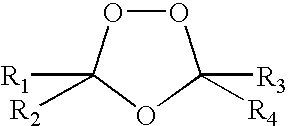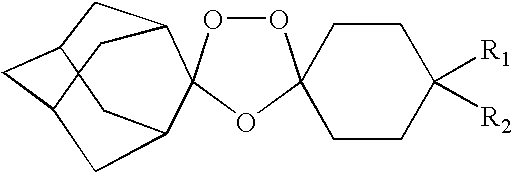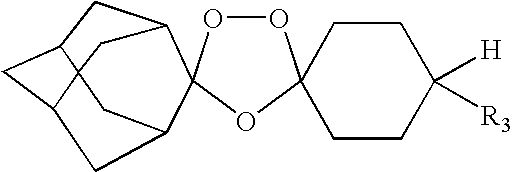Spiro and dispiro 1,2,4-trioxolane antimalarials
a trioxolane and antimalarial technology, applied in the field of compositions and methods for treating malaria, can solve the problems of inability to prevent disease recurrence, difficult treatment of malaria, and inability to cure malaria, etc., to achieve easy and inexpensive synthesizing, excellent potency and efficacy, and low degree of neurotoxicity
- Summary
- Abstract
- Description
- Claims
- Application Information
AI Technical Summary
Benefits of technology
Problems solved by technology
Method used
Image
Examples
example 1
Antimalarial Activity of OZ370-OZ405
Antimalarial Assays
[0065] Each trioxolane was screened against the chloroquine-resistant K1 and chloroquine-sensitive NF54 strains of Plasmodium falciparum in vitro. In the single dose in vivo screen, NMRI mice infected with the ANKA strain of P. berghei (groups of five mice) were treated one day post-infection with trioxolanes dissolved or suspended in standard suspending vehicle (SSV). The SSV consists of 0.5% w / v CMC, 0.5% v / v benzyl alcohol, 0.4% v / v Tween 80, and 0.9% w / v sodium chloride in water. Trioxolanes are administered as single 10 and 3 mg / kg po doses. Antimalarial activity was measured by percent reduction in parasitemia on day three post-infection and survival times compared to an untreated control group. Survival to day 30 post-infection is considered to be a cure. For comparative analysis, data is also presented for the control antimalarial drugs artemether (AM), artesunate (AS), chloroquine (CQ), and mefloquine (MFQ).
[0066] B...
example 2
Effect of Trioxolanes On Schistosoma Species
[0067] Effect of Trioxolane OZ207 On Schistosoma japonicum
TABLE 2Comparative effect of OZ207 and artemether in mice infected with Schistosoma japonicumMiceAge ofDosewithoutMTWB / MFWB / Drugworm(mg / kg × 1)♀ wormx ± SDWRR / %x ± SDFWRR / %Control——0 / 826.6 ± 4.2 —11.6 ± 2.4 —OZ20735 days2004 / 79.1 ± 3.9660.6 ± 0.795OZ20735 days4004 / 64.3 ± 1.2840.7 ± 1.294Artemether35 days4000 / 710.1 ± 4.4 623.4 ± 1.671OZ207 7 days2000 / 85.4 ± 2.4812.1 ± 1.082
MTWB, mean total worm burden;
WRR, worm reduction rate
MFWB, mean female worm burden;
FWRR, female worm reduction rate.
[0068] Table 3 illustrates that the mean total worm burden and mean female worm burden in OZ207 400 mg / kg group was significantly lower than those in artemether 400 mg / kg group (P<0.01). The mean female worm burden in OZ207 200 mg / kg group was also significantly lower than that in artemether group (P<0.01).
Effect of Trioxolanes On 21-Day-Old Schistosomules
[0069] Mice were infected with 100 Sc...
example 3
Activity of Trioxolanes Against P. berghei
[0071] In the single dose ED50 / ED90 / ED99 determinations, Moro SPF or NMRI mice (group of three) infected with the ANKA strain of Plasmodium berghei were treated on day one post-infection. Trioxolanes were dissolved or suspended in the standard suspending vehicle (SSV) and administered as single 10, 6, 3, 1, 0.3, and 0.1 mg / kg doses po and sc. The SSV consists of 0.5% w / v CMC, 0.5% v / v benzyl alcohol, 0.4% v / v Tween 80, and 0.9% w / v sodium chloride in water. Antimalarial activity was measured by percent reduction in parasitemia on day three post-infection. The ED50 / ED90 values were calculated by nonlinear fitting.
TABLE 4CompdED50 (mg / kg)ED90 (mg / kg)ED99 (mg / kg)OZ2770.782.04.4OZ2790.631.83.9Artesunate4.71960Artelinate4.81018Artemether2.24.27.1Chloroquine1.83.55.9Mefloquine4.05.46.8
[0072] Table 4 shows ED50 / ED90 / ED99 data obtained by po administration of trioxolanes in the SSV formulation. The relatively lipophilic artemether is substantiall...
PUM
| Property | Measurement | Unit |
|---|---|---|
| compositions | aaaaa | aaaaa |
| transmission | aaaaa | aaaaa |
| resistance | aaaaa | aaaaa |
Abstract
Description
Claims
Application Information
 Login to View More
Login to View More - R&D
- Intellectual Property
- Life Sciences
- Materials
- Tech Scout
- Unparalleled Data Quality
- Higher Quality Content
- 60% Fewer Hallucinations
Browse by: Latest US Patents, China's latest patents, Technical Efficacy Thesaurus, Application Domain, Technology Topic, Popular Technical Reports.
© 2025 PatSnap. All rights reserved.Legal|Privacy policy|Modern Slavery Act Transparency Statement|Sitemap|About US| Contact US: help@patsnap.com



